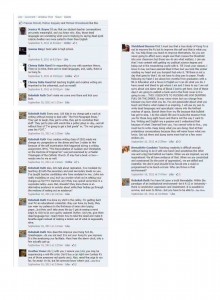In 2001, The Ari Files was a weekly column I’d kept for several years. When 9/11 happened, my son, Noah, was going on three. Kezia, my daughter, had just turned one. Jan and I were in a tough spot financially, so I picked up some classes at the University of North Florida. I was on my way to teach what was my first fiction workshop there when I saw folks gathered in front of a TV screen in the public area of the building where the class was held. Through the spaces between shoulders and heads, I watched a clip of a plane smashing into the towers. A part of me didn’t believe it was real. Another part instantly knew it was. My brain couldn’t buy it. But all the flesh and blood–it was like falling through myself. Just falling. And I didn’t know I was crying until I heard the sound of it.
I know I musthave gone to the classroom, but that’s all blank now. I don’t know what I said, what I did.
That night, I took down The Ari Files. I’d wanted to write something, but couldn’t. So I just took it down. And it stayed down for nearly two weeks. The following is from September 23, 2001.
Words and One Eye Open
Some folks have written me to ask why The Ari Files has gone dark. I’ve thinking of two, a couple of pals–a Canadian and a Staten Islander–who thought I shouldn’t just clam up, that I should write something about what I’m feeling.
The Canadian had lived for some years in New York City, long enough to become part of a neighborhood. That’s how you become a New Yorker. That’s how she gets under your skin. Once you’ve got a neighborhood, you’ve got the whole town, and you take her with you for the rest of your life.
New York makes you a part of her. The timing, the tension, rubbing bellies in narrow green grocer aisles; breaths shared, mouth to mouth, over meek distances in crowded trains and elevators and laundromats; the confluence of streams of humanity bunching up on street corners and sliding, headlong, up and down sidewalks in human eddies; words spoken or left in the bubbling stir of thoughts behind blinking eyes; all the living and some presumed dead languages of humanity escaping from tongues and through ears to cling to the sides of buildings and on window glass, making dunes in the panes; words mixed with carbonic soot and just as black. Black. The color of the deep and distance and the unknown. The color of poets in leather jackets or cotton Ts. The black of boots and berets and moons beneath tired eyes and asphalt. The black of Homburgs in Williamsburg and Borough Park. The Lower Eastside black of fishnet stockings and hip tight skirts and dyed hair and painted lips and fingers and toes. Ebony Jazz. The black beard of dockside Romeo dropping fishhooks into the inky Narrows. The glossed lampblack empty nucleus of an open eye through which everything may enter and beyond which everything is revealed, including the wonder of ultimate unknowability. This black pools in the pores of your skin. You carry it with you. It gets into your blood. It stripes your soul with a brush dipped into a concentrate of richly mixed humanity.
My Canadian friend took the terror planes in his belly. Just like the rest of us. The Staten Islander lost a dozen of his people. Oh God. The scent of dear flesh blown from bones onto the air in fire and chemical smoke. Screams and tears rush into the hollows of charred periosteum. Eardrums shatter. Silence, desperate leaps. There is no air left in the world.
Everyone is missing now. Everyone. What words could there possibly be?
We need time. To catch our breaths after a blow to the windpipe. To let cohesion return to the mind. To let sadness have sway. To squeeze rage out of our rag hearts and let it drain into gutters. To bury our dead.
What can I say? Watch your back. All this sadness and rage: we’re going to be crazy from it for a while. You’ll have to sleep lightly now. And keep an eye on that guy over there wrapped in a flag. I think he’s looking for trouble. Better keep one eye open at all costs. For safety’s sake. I’m talking about the neighborhood here.

